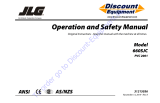Frequent/Periodic/Annual/PDI Checklist
Vertical Mast, Electric Scissor, Micro Scissor & Rough Terrain
Serial Number: Starting with serial number A/B000 000 000 or 09 000 000 and above
Use this table for pre-delivery inspections (PDI) before each rental, lease or sale and as an instruction for all frequent inspections and annual inspections.
Refer to the operation and service manuals for inspection instructions (for example, visual inspection and function tests, torque specs, engine oil, chain
inspection intervals, and more).
B - Do the pre-delivery inspection before the machine is sent out or during the frequent inspections at 200 days or 200 hour
intervals. For more instructions, refer to the operation and service manuals.
C - Do the scheduled maintenance Inspections each year. For more instructions, refer to the operation and service manuals.
P - Pass
N/A - Not Applicable
Put a check mark on the “Pass” column as you meet the requirements of the inspection of each item. Add a comment if the item does not pass inspection.
Model:
Hourmeter Reading:
Date/Time:
Inspection Type (Choose one): Pre-delivery Frequent Periodic Annual
Product User:
Product Owner:
Inspection Type Schedule
PDI/Frequent/Periodic B
Annual B+C
Items for Inspection P N/A
Service Bulletins. Make sure there are no open service bulletins. B
Annual Inspection. Make sure you complete it within 13 months. B
Labels. In place, correctly attached & you can read them. B
Limit Switches. Correctly installed & no obstructions or damage. B
BASE/ENGINE
Engine and Components. Do a check on engine and components for any
loose, missing, damaged, or failed items. Make sure you do not exceed the
recommended uid, oil and coolant change intervals.
B
Engine and Components. Replace the engine oil and lter. C
Engine Intake Air Filter. No damage or missing component. Remove dirt & dust. B
Engine Intake Air Filter. Replace the air lter if necessary. C
Engine Oil. Oil level between “L” and “H”. Make sure you do not exceed the oil
change interval. B
Radiator. Correctly attached & no damage or missing components. Do a check
of coolant level. B
Radiator. Do a check of coolant level & condition & replace if necessary. C
Fuel Tank & Lines. Filler cap, tank, ttings and hoses are tightly closed & no
damage or leaks. B
Propane Tank & Lines. Straps are correctly installed to brackets &
couplers are tight. Make sure there are no damage or leaks. B
Outriggers. No damage or missing components. B
Pothole Protection. Both sides have no obstructions, dirt or damage. B
Battery/Hydraulic Tray. Trays are latched tightly & no missing components. B
Batteries. No damage, tight connections & sufcient uid levels. Clean terminals
and cable ends. B
Battery Charger. Correctly attached & no damage. B
Steer Assembly. Correctly attached & no damage leaks or missing components. B
Wheel/Tire Assembly. Do a check of all tires for damage, missing parts, wear &
correctly aligned. B
Wheel/Tire Assembly. Wheel nuts torqued as recommended. C
Axles. Correctly attached & no missing components. Tight ttings and hoses &
no leaks. B
Axles. Do a check and replace oil if necessary. C
Hydraulic Tank, Pump, Motor & Lines. Filler cap, hoses, and other hydraulic
components are closed tightly & no damage or leaks. B
Hydraulic Oil. Level at, or slightly above top mark. B
Hydraulic Oil. Do a check and replace oil and lters if necessary. C
Electrical Components. Do a check on all electrical components such as the
motor controller if necessary. Correctly attached & no damage. Tight wire con-
nections and fasteners.
B
Items for Inspection P N/A
Manifolds. Tight ttings and hoses & no damage or leaks. Tight wire
connections, no missing components & correctly working valves. B
Main Power Disconnect Switch. Cables tight & in working order. B
Base Controls. Operate switches and make sure they all operate correctly. No
damage or missing components. B
Brakes. Correctly attached & no damage or leaks. B
Brakes. Do a check on disc wear and replace if necessary. C
Base Weldment. No deformation or cracks. B
Grease Points. No obstructions, dirt, or damage. Add grease if necessary. B
Ladder. Correctly attached & no damage. B
Tilt Sensor. Correctly attached & no damage. B
LIFTING MECHANISM - MAST/SCISSORS
Maintenance Support(s). Correctly attached & no damage. B
Scissor Assembly & Bumpers. Correctly attached, no deformation/damage.
Cables & wires installed with no damage. B
Sliders & Rollers. Correctly attached & no obstructions, dirt, or damage/wear. B
Lift Cylinder(s). No damage or missing components. Tight ttings and hoses &
no leaks. Correctly installed. B
Angle Transducer. Correctly attached & no damage. B
Scissor Pins. Correctly attached & no damage. B
Mast Assembly. No damage, cracks or deformation. B
Mast Assembly. Lubricate the mast as recommended. C
Chains, Rollers & Control Cables. No damage or missing components. B
Wear Pads. No damage/wear or missing components. Fasteners tight. B
PLATFORM
Railings and Gate. Correctly attached & no damage or missing
components. B
Fall-Protection Anchorage. Attachment rings correctly attached & no damage. B
AC Power Socket. No obstructions, dirt, or damage. B
Platform Control Console. Operate the switches and make sure they all
operate correctly. No damage or missing components. B
Manual Storage Box. Manuals and documents are in the storage the box, in
good condition, and you can read them. B
Powered Extension Control Console. Operate switches and make sure they
all operate correctly. No damage or missing components. B
Extension Platform. Correctly attached & no damage or missing components. B
Function Tests. Refer to the operation manual for your serial number for
information on how to run these tests.
PASS
FAIL
Comments:
Print Name
Print Name
Owner:
User:
199341ADA
Signature
Signature
Date (DD/MM/YY)
Date (DD/MM/YY)
The undersigned has made sure that all areas in the list have received an inspection.
The undersigned has told the machine owner of all inconsistencies in the inspection and corrected them before machine operation.























